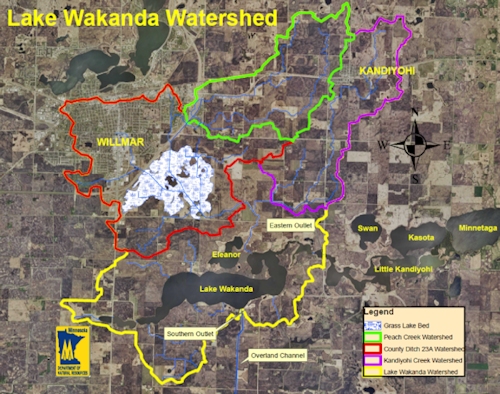 |
Management Plans
Cooperative Enhancement Plan May 2015 Lake Wakanda Enhancement Plan (Informational Presentation to Kandiyohi County Board - February 17th, 2014) Common Carp (Cyprinus carpio) Asian carp invading Minnesota watersThe Minnesota Department of Natural Resources is working hard to stop the invasion of Asian carp into Minnesota waters. Asian carp have two species that pose a large threat. The bighead carp can reach 100 lbs and eats so much it leaves nothing for Minnesota's native species of fish. The silver carp is not as voracious as the bighead carp, but pose a danger because they leap out of the water when boats pass. Bighead carp have been caught in the St. Croix River in 1994 and Lake Pepin in 2004 and just last months. The DNR is trying to determine the best way to stop this invasion. One idea is revolves around building barriers of light, sound, bubbles or electricity on waterways to keep the invasive fish moving upsteam into Minnesota waters. However, this project isn't guaranteed to work and would be extremely expensive. Related:

IdentificationGeneral description: The large, big-scaled carp has a light gold color and has a long dorsal fin. It has two pairs of barbels (whiskers) and a lipped mouth similar to a sucker. Size: It's not unusual for carp to reach 30 or more pounds. The Minnesota record is 55 pounds, 5 ounces, caught in Clearwater Lake in Wright County in 1952. Color: Carp are bronze to greenish with a light underside. They have orange dorsal and pectoral fins. ReproductionIn spring, after the water warms up, carp move upstream in a river or congregate in shallow, weedy lake water. Females lay large numbers of eggs--up to 2 million at a time. The males fertilize eggs after the females spread them about in the shallow water. Eggs hatch after several days. FoodYoung carp eat mainly plant material, such as seeds. Older ones prefer water insects, snails, fish eggs, and plant parts. PredatorsAlthough they're not considered good eating by most Minnesotans, carp are an important food source for many people. Worldwide, more than 200,000 tons are harvested each year. Small carp are eaten by many predator fish such as walleye and northern pike. Habitat and range
Carp live in lakes and rivers, marshes, and ponds throughout Minnesota. They are not too fussy about their habitat, but they prefer weedy, shallow, warm areas. Carp tend to gather in small schools. Population and managementAlthough European Americans introduced carp intentionally to Minnesota, today the DNR is trying to reduce populations and prevent them from spreading to other lakes. It is illegal to transplant carp in Minnesota or to use live carp for bait. Fun factsCarp feed by slurping in mud from the bottom of the lake or river, spitting out the muck, and eating the edible food, such as seeds and insects. Because this disturbs the lake bottom and suspends mud and nutrients, this feeding method can muddy up a lake or wetland. In Europe this species is raised in ponds for food. For more information...Find out more about the Common Carp from:
|
© Lake Wakanda Chain |
